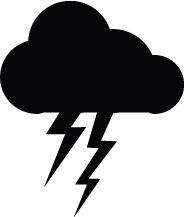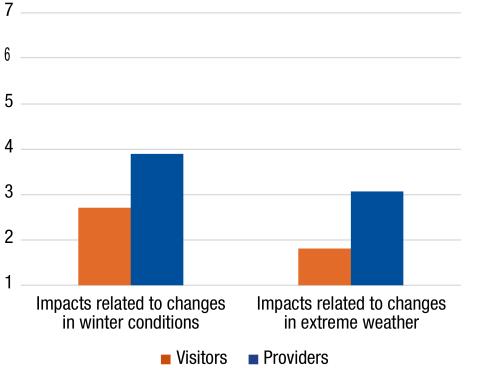Key Findings




Outdoor Recreation Participation and Climate Impacts Both Growing
Outdoor recreation is a key part of both the New Hampshire economy and way of life. It is responsible for over 30,000 jobs in the state, representing 3.2 percent of the state gross domestic product (GDP) from both in-state and out-of-state participants.1 Outdoor recreation visitation has steadily risen in the United States, with a dramatic increase in the last five years, partly due to the COVID-19 pandemic.2 Within the White Mountain National Forest of New Hampshire, outdoor recreation increased by close to 50 percent from 2015 to 2020.3
This long-term rise in visitation occurred simultaneously with a range of climate-related impacts on outdoor recreation, including shifting seasons,4 increases in the occurrence of extreme weather events,5 and warmer winters.6 Moreover, the North Central and Northeast regions of the country are experiencing climate change impacts on outdoor recreation more acutely than anywhere else in the contiguous United States.7 This combination of stressors poses a risk to both the quality of visitors’ outdoor recreation experiences and the natural environments in which these experiences take place.8
Climate-related impacts also place unprecedented pressure on the outdoor recreation providers responsible for maintaining outdoor recreation spaces and visitor experiences.9 Here, we examine to what extent outdoor recreation providers and visitors in New Hampshire are impacted by annual climatic conditions representative of long-term trends, specifically, through the 2024–2028 New Hampshire Statewide Comprehensive Outdoor Recreation Plan (SCORP). For the first time, the New Hampshire SCORP included an investigation of climate-related impacts on outdoor recreation from the perspective of both visitors (n=1,364) and providers (n=348) (see Box 1).
The findings of the study uncovered notable disparities in how New Hampshire’s outdoor recreation providers and visitors perceive climate conditions’ impact on outdoor recreation, particularly in the categories of “winter” and “extreme weather” (Figure 1). Understanding the perspectives of both providers and visitors is critical to outdoor recreation planning because of outdoor recreation’s contributions to the state economy10 and the role it plays in incentivizing people to live in New Hampshire.11
Figure 1. Average Level of Perceived Impact on Outdoor Recreation in New Hampshire from Changes in Annual Climatic Conditions Representative of Long-Term Trends (2022–2023)

Note: “M” indicates mean across a 1-7 Likert scale (1 = no impact, 7 = major impact).
Figure 1 shows that both groups (e.g., visitors and providers) identified “winter” as the area most impacted by climate. Across all categories, recreation providers reported higher perceived impacts compared to visitors, with the most pronounced differences occurring in the “winter” and “extreme weather” variables. More detailed information, including valid percentages for all impacts measured can be found within the 2024–2028 SCORP.12
Box 1: Definitions
Visitors: New Hampshire residents from across the state who were 18+ years of age and who had participated in outdoor recreation in New Hampshire within the past 12 months.
Providers: Any individual representing an outdoor organization that provides and/or promotes outdoor recreation in New Hampshire.
Winter Impacts on Providers and Visitors
New Hampshire winters have historically been characterized by cold and snowy conditions that provide opportunities for many winter outdoor recreation activities. Yet, in the past 50 years, New Hampshire has lost approximately three weeks of snow-covered days13 and the ice-out dates14 on Lake Winnipesaukee are averaging eight days earlier.15 Although New Hampshire has tools for enhancing snow availability (for instance, machine snowmaking) these technologies still require temperatures below freezing. Moreover, snowmaking does not aid activities that rely on natural winter conditions, such as ice fishing, pond hockey, backcountry skiing, ice climbing, and snowmobiling. As winters continue to shorten,16 it is anticipated that visitors will adapt their behaviors to capitalize on increased recreational opportunities in the “shoulder seasons,” or the months between peak and off-seasons of recreation.17 This presents a challenge for providers who manage seasonal staff hires whose availability often does not align with the earlier/later demand for warm weather activities.18
When asked about the impact of changing winter conditions, the findings suggest that both visitors and providers were impacted (Figure 1). However, the groups diverged in what they identified as the most impactful change for outdoor recreation: while visitors indicate that “warmer winter seasons” were most impactful, providers indicate that “shorter winter seasons” were top of the list (Table 1).
Table 1: Perceptions of Climate Impacts on Outdoor Recreation in New Hampshire by Item
| Construct M (SD) |
Item |
Visitor |
Provider M (SD) |
|---|---|---|---|
|
Extreme Weather |
Damage to recreation infrastructure from storms (e.g., downed trees, flooding) | 1.83 (1.24) |
3.52 (1.83) |
| Loss of recreation access from storms (e.g., road/trail closures, poor trail conditions) | 1.74 (1.20) |
2.89 (1.70) |
|
| Negative travel impacts from storms (e.g., poor road conditions, ice, snow, rain, wind) | 1.87 (1.30) |
2.80 (1.55) |
|
|
Water/Wildlife |
Decreased wildlife populations (e.g., fish, birds, mammals) | 2.06 (1.61) |
2.46 (1.79) |
| Fluctuating water levels (e.g., rivers, ponds, lakes, estuaries, ocean) | 2.14 (1.50) |
3.23 (1.99) |
|
| Decreased water quality (e.g., E. coli, algal blooms, bacteria) | 2.05 (1.58) |
2.72 (1.96) |
|
|
Forests |
Less vibrant fall foliage (e.g., less fall colors, less intensity) | 1.90 (1.46) |
2.06 (1.46) |
| Later peak foliage (e.g., fall foliage starting later) | 1.69 (1.27) |
2.07 (1.55) |
|
| Decreased tree populations (e.g., tree death, disease, less species diversity) | 1.94 (1.46) |
2.63 (1.91) |
|
|
Summer |
Hotter summer seasons (e.g., unseasonably warm summer days) | 2.63 (1.93) |
2.75 (1.95) |
| Longer summer seasons (e.g., summer starting earlier, lasting later) | 2.11 (1.65) |
2.90 (1.95) |
|
| More frequent heatwaves (e.g., extreme summer heat) | 2.64 (1.90) |
2.82 (1.97) |
|
|
Winter |
Warmer winter seasons (e.g., unseasonably warm winter days) | 2.80 (2.04) |
3.91 (2.33) |
| Shorter winter seasons (e.g., snow starting later, snow melting earlier) | 2.63 (2.02) |
3.93 (2.31) |
|
| Fewer days of snow/ice cover (e.g., reduced snowpack) | 2.71 (2.05) |
3.85 (2.32) |
Note: “M” indicates mean across a 1-7 Likert scale; “SD” indicates standard deviation. (1 = no impact, 7 = major impact).
Providers Feel the Impact of Extreme Weather
Strong winds, heavy rainfall, ice storms, and high tides have an immediate effect on outdoor recreation areas and programs as well as long-term, post-disaster impacts.19 From 1980 to 2023, New Hampshire experienced 20 separate billion-dollar disaster events.20 In February 2023, New Hampshire was actively managing recovery efforts for eight natural disasters,21 and in December 2023 New Hampshire experienced one of its most significant storms on record in the form of a heavy rain-on-snow event.22 According to the New Hampshire Climate Assessment, extreme precipitation dramatically increased between 1996 and 2016.23 For visitors, extreme weather events can deter plans to travel for recreation24 or negatively impact their experiences.25 Increasing intensity and frequency of storms causes financial strain for providers who need to keep up with annual maintenance costs and find additional funds for emergency repairs.26
When asked about extreme weather events, our findings suggest that providers were substantially more impacted than visitors (Figure 1). Additionally, the extreme weather category is where the two stakeholders’ perceptions of impact differed the most (Table 1).
Outdoor Recreation Providers—The ‘Canary in the Coal Mine’ for Climate Impacts
Outdoor recreation represents a cornerstone of New Hampshire’s economy and is a staple of the state’s identity and lifestyle. Yet, increased participation may collide with increased climate impacts and result in a perfect storm of more people competing for fewer recreation days/opportunities. In turn, that collision of impacts has the potential to negatively impact both provider and visitor experiences. This study’s findings suggest New Hampshire outdoor recreation providers are considerably more aware of the impacts from climate conditions than visitors—a finding consistent with research on general differences between visitor and providers perceptions.27 Within this study, the most substantial differences occurred in “damage to recreation infrastructure from storms” and “shorter winter seasons.”
Higher perceived impacts amongst providers could, in part, be shaped by negative feedback from a small group of visitors who do not accurately represent the average visitor experience. However, it is also important to note that providers may be more in tune with recreation resources and activities due to a substantially greater number of days on-site compared to visitors.28 As such, providers often serve as the “canary in the coal mine” for climate condition impacts on outdoor recreation. They detect early indicators of change and/or danger given their recreation management roles.
Can New Hampshire Outdoor Recreation Adapt to a Changing Climate?
Our study findings aligned with prior research on New Hampshire providers impacted by winter and extreme weather impacts,29 which suggests that New Hampshire providers may disagree with the notion that outdoor recreation can easily adapt to meet a changing climate.30 As one provider noted, “To put it plainly, I’m not sure how much longer operating in New Hampshire in the winter is going to be viable. We have already begun looking for opportunities elsewhere.”
Findings on visitors were also consistent with previous reports on winter impacts,31 with more than half of visitors perceiving climate-related impacts. One visitor remarked, “I’ve been reconsidering season passes at ski areas for my kids and myself due to the shorter winter season and poorer snow conditions.” However, findings differed from the literature on the potential impact of extreme weather on the visitor experience.32 Visitors reported minimal impact in this area, suggesting that a majority are either unaware of the extent of damage caused by extreme weather in New Hampshire33 or are more ready to adapt their outdoor recreation to accommodate the changes caused by extreme weather events. Overall, these findings suggest that providers are more aware of climate related impacts on outdoor recreation than visitors. Utilizing provider perceptions as a guide when shaping outdoor recreation climate adaptation plans could prevent further impacts from reaching visitors.
Visitors’ perceptions suggest that providers are doing well at maintaining positive outdoor recreation experiences in the face of both climate and crowding impacts. By contrast, providers’ responses suggest that climate conditions are already impacting their experiences. While they can maintain positive visitor experiences right now, additional support is needed to continue doing so, particularly in response to changing winter conditions and extreme weather events. Within outdoor recreation, examples of adaptive management strategy include building floating docks for fluctuating water levels, implementing reservation systems for crowd control, and offering live snow reports to manage expectations. However, a challenge associated with any climate adaptation strategy is the cost associated with implementation and maintenance. This challenge is further complicated by the fact that many parks and protected areas are funded by visitor fees. This visitor-funded model may exacerbate climate-related issues because, currently, additional funding to combat climate impacts would need to come from increased visitation, creating a negative feedback loop.34
Supporting Outdoor Recreation and Its Providers
Our results indicate that for outdoor recreation to continue thriving in New Hampshire, climate adaptation responses should prioritize the providers responsible for maintaining outdoor recreation spaces and experiences. Based on study findings from both stakeholder groups, three overarching climate adaptation recommendations were created and included in the “recreation and the environment” priority area of the 2024–2028 SCORP.
- Design and redesign outdoor recreation areas to be adaptable to seasonal shifts and to minimize visitor impacts on the natural environment.
- Foster stewardship for New Hampshire outdoor recreation areas through educational messaging and programs.
- Strengthen interagency relationships and work collaboratively to develop a shared set of guiding principles for sustainable outdoor recreation management across New Hampshire parks and protected areas.
Each recommendation has accompanying action steps and performance measures aimed at supporting outdoor recreation providers. Providers seeking additional support could benefit from programs like the Northern Institute of Applied Climate Science’s adaptation workshop and workbook35 or National Centre for Outdoor Risk and Readiness Weather and Environmental Conditions Hub through Outward Bound Australia.36 More information about New Hampshire efforts to preserve outdoor recreation experiences and spaces for future generations can be found in the 2024-2028 New Hampshire Statewide Comprehensive Outdoor Recreation Plan.
Methods
Every five years, New Hampshire completes a Statewide Comprehensive Outdoor Recreation Plan (SCORP) to qualify for federal land and water conservation funding to support outdoor recreation across the state. The SCORP helps justify federal and state outdoor recreation expenditures and serves as a guidebook for growth, planning, and management for the ensuing five years. A key characteristic of the SCORP is that it identifies challenges facing outdoor recreation in the state through extensive public engagement surveys of New Hampshire outdoor recreation visitors and providers.
The study utilized a mixed-methods approach, asking questions in five thematic areas or categories plus one open-ended follow-up question. The categories were derived from the 2019–2023 SCORP37 and included: 1) extreme weather (three items); 2) water/wildlife (three items); 3) forests (three items); summer (three items); and winter (three items).38 Visitors to outdoor recreation spaces were defined as New Hampshire residents from across the state who were 18+ years of age and who had participated in outdoor recreation in New Hampshire within the past 12 months. Providers were defined as any outdoor organization that provides and/or promotes outdoor recreation in New Hampshire.
The visitor survey was conducted in late winter/spring 2023 through a partnership between the University of New Hampshire (UNH) Recreation Management and Policy (RMP) research team and the UNH Survey Center. The Survey Center’s Granite State Panel randomly selected New Hampshire residents over 18 who participated in outdoor recreation in New Hampshire within the past year. The visitors were asked “to what extent have the following climate conditions impacted your outdoor recreation experience(s) in New Hampshire in the last 12 months?” The 15 individual climate items were evaluated on a seven-point Likert scale (1= no impact and 7= major impact) (Table 1). In total, 1,364 visitors responded to the survey, yielding a response rate of 19 percent.
For the provider survey, the UNH RMP research team worked with the New Hampshire Office of Outdoor Recreation Industry Development to acquire an inventory of all New Hampshire outdoor recreation providers. Respondents were asked “To what extent have the following climate conditions impacted the outdoor recreation resources, areas, facilities, programs, and/or staff that your visitors/constituents/clients utilize in New Hampshire over the last 12 months?” The same 15 individual climate items asked of visitors were evaluated on the same seven-point Likert scale (Table 1). In total, 348 providers responded to the survey, resulting in a response rate of 39 percent. More detailed information can be found within the 2024–2028 SCORP.39
Provider and visitor responses are in reference to the winter and early spring of 2022 through winter and early spring of 2023. Winter 2021–2022 was 3.3 °F above average, and winter 2022–2023 was 8.2 °F above average.40
Endnotes
- Outdoor Recreation Satellite Account, U.S. and States, 2022 News Release | U.S. Department of Commerce. Bureau of Economic Analysis (BEA). (11-17-2023). Retrieved February 11, 2024, from https://www.bea.gov/sites/default/files/2023-11/orsa1123.pdf
- Ferguson, M. D., McIntosh, K., English, D. K., Ferguson, L. A., Barcelona, R., Giles, G., Fraser, O, & Leberman, M. (2022c). The Outdoor Renaissance: Assessing the Impact of the COVID-19 Pandemic upon Outdoor Recreation Visitation, Behaviors, and Decision-Making in New England’s National Forests. Society of Natural Resources. DOI: 10.1080/08941920.2022.2055247; Ferguson, M. D., Lynch, M. L., Evensen, D., Ferguson, L. A., Barcelona, R., and Giles, G. (2022d). The nature of the pandemic: Exploring the negative impacts of the COVID-19 Pandemic upon recreation visitor behaviors and experiences in parks and protected areas. Journal of Outdoor Recreation and Tourism. DOI: 10.1016/j.jort.2022.100498
- Ferguson, M. D., Giles, G., Ferguson, L. A., Barcelona, R., Evensen, D., Barrows, C., & Leberman, M. (2022b). Seeing the forest for the trees: A social-ecological systems approach to managing outdoor recreation visitation in parks and protected areas. Journal of Outdoor Recreation and Tourism, 38, 100473. https://doi.org/10.1016/j.jort.2021.100473
- Young, S. S., & Young, J. S. (2021). Overall Warming with Reduced Seasonality: Temperature Change in New England, USA, 1900–2020. Climate, 9(12), 176. https://doi.org/10.3390/cli9120176
- Lemcke-Stampone, M. D., Wake, C. P., & Burakowski, E. (2022). New Hampshire Climate Assessment 2021. https://scholars.unh.edu/cgi/viewcontent.cgi?article=1071&context=sustainability
- Wilson, G., Green, M., & Mack, K. (2018). Historical Climate Warming in the White Mountains of New Hampshire (USA): Implications for Snowmaking Water Needs at Ski Areas. Mountain Research and Development, 38(2), 164–171. https://doi.org/10.1659/MRD-JOURNAL-D-17-00117
- Askew, A. E., & Bowker, J. M. (2018). Impacts of Climate Change on Outdoor Recreation Participation: Outlook to 2060. The Journal of Park and Recreation Administration, 36(2), 97–120. https://doi.org/10.18666/JPRA-2018-V36-I2-8316
- Voorhis, J., McDowell, G., Burakowski, E., & Luneau, T. (2023). The implications of warmer winters for ice climbing: A case study of the Mount Washington Valley, New Hampshire, USA. Frontiers in Human Dynamics, 5. https://www.frontiersin.org/articles/10.3389/fhumd.2023.1097414
- Laskin, J. (2024, January 19). Backcountry Skiing Is Booming in the Northeast. But Can It Survive? New York Times. Retrieved January 26, 2024, from https://www.nytimes.com/2024/01/19/travel/northeast-backcountry-skiing-threatened.html; Voorhis, J., McDowell, G., Burakowski, E., & Luneau, T. (2023). The implications of warmer winters for ice climbing: A case study of the Mount Washington Valley, New Hampshire, USA. Frontiers in Human Dynamics, 5. https://www.frontiersin.org/articles/10.3389/fhumd.2023.1097414
- Outdoor Recreation Satellite Account, U.S. and States, 2022 News Release | U.S. Department of Commerce. Bureau of Economic Analysis (BEA). (11-17-2023). Retrieved February 11, 2024, from https://www.bea.gov/sites/default/files/2023-11/orsa1123.pdf
- Stay Work Play New Hampshire is a non-profit that focuses on the values of living, working, and playing in New Hampshire to help keep younger populations of adults from leaving the state. Their website specifically highlights outdoor recreation as part of that message.
- Ferguson, M. D. & Frye, M. (2023). 2024–2028 New Hampshire Statewide Comprehensive Outdoor Recreation Plan. Submitted to New Hampshire DNCR - Division of Parks and Recreation, Concord, New Hampshire.
- Young, S. S., & Young, J. S. (2021). Overall Warming with Reduced Seasonality: Temperature Change in New England, USA, 1900–2020. Climate, 9(12), 176. https://doi.org/10.3390/cli9120176
- Where ice covering the surface of a body of water breaks up due to thawing and areas of open water become prevalent. https://www.epa.gov/climate-indicators/climate-change-indicators-lake-ice#tab-3
- Lemcke-Stampone, M. D., Wake, C. P., & Burakowski, E. (2022). New Hampshire Climate Assessment 2021. https://scholars.unh.edu/cgi/viewcontent.cgi?article=1071&context=sustainability
- Burakowski, E. A., Contosta, A. R., Grogan, D., Nelson, S. J., Garlick, S., & Casson, N. (2022). Future of Winter in Northeastern North America: Climate Indicators Portray Warming and Snow Loss That Will Impact Ecosystems and Communities. Northeastern Naturalist, 28(sp11). https://doi.org/10.1656/045.028.s1112
- Fisichelli, N. A., Schuurman, G. W., Monahan, W. B., & Ziesler, P. S. (2015). Protected Area Tourism in a Changing Climate: Will Visitation at US National Parks Warm Up or Overheat? PLOS ONE, 10(6), e0128226. https://doi.org/10.1371/journal.pone.0128226
- O’Toole, D., Brandt, L. A., Janowiak, M. K., Schmitt, K. M., Shannon, P. D., Leopold, P. R., Handler, S. D., Ontl, T. A., & Swanston, C. W. (2019). Climate Change Adaptation Strategies and Approaches for Outdoor Recreation. Sustainability, 11(24), Article 24. https://doi.org/10.3390/su11247030
- Ferguson, M. D. & Frye, M. (2023). 2024–2028 New Hampshire Statewide Comprehensive Outdoor Recreation Plan. Submitted to New Hampshire DNCR - Division of Parks and Recreation, Concord, New Hampshire. https://www.nhstateparks.org/NHStateParks/media/NHStateParks/PDFs/Community-Recreation/NH-SCORP-2024-28-Final-3-5-24-(1).pdf
- NOAA National Centers for Environmental Information (NCEI) U.S. Billion-Dollar Weather and Climate Disasters (2024). Retrieved January 24, 2024, from https://www.ncei.noaa.gov/access/billions/state-summary/NH
- Sununu, Christopher. “Request for Presidential Major Disaster Declaration” (2-17-2023). State of New Hampshire, Office of the Governor. Retrieved January 24, 2024, from https://www.nh.gov/safety/divisions/hsem/documents/2023-02-17-signed-disaster-letter-to-potus.pdf
- Estabrook, E. (2023, December 28). Rain-on-snow: A closer look at December’s unprecedented flooding. Mount Washington Observatory. https://mountwashington.org/rain-on-snow-a-closer-look-at-decembers-unprecedented-flooding/
- The period from 1996 to 2016 compared to 1991 to 1995 saw a 50% increase in extreme precipitation. Extreme precipitation is quantified as more than one inch of rain in 24 hours or more than 4 inches in 48 hours. Lemcke-Stampone, M. D., Wake, C. P., & Burakowski, E. (2022). New Hampshire Climate Assessment 2021. https://scholars.unh.edu/cgi/viewcontent.cgi?article=1071&context=sustainability
- De Urioste-Stone, S. M., Le, L., Scaccia, M. D., & Wilkins, E. (2016). Nature-based tourism and climate change risk: Visitors’ perceptions in mount desert island, Maine. Journal of Outdoor Recreation and Tourism, 13, 57–65. https://doi.org/10.1016/j.jort.2016.01.003
- Huebner, A. (2012). Public perceptions of destination vulnerability to climate change and implications for long-haul travel decisions to small island states. Journal of Sustainable Tourism, 20(7), 939–951. https://doi.org/10.1080/09669582.2012.667107
- Ferguson, M. D. & Frye, M. (2023). 2024–2028 New Hampshire Statewide Comprehensive Outdoor Recreation Plan. Submitted to New Hampshire DNCR - Division of Parks and Recreation, Concord, New Hampshire.
- Manning, R. E., & Valliere, W. A. (2011). Coping in outdoor recreation: Causes and consequences of crowding and conflict among community residents. Journal of Leisure Research, 33(4), 410–426. https://doi.org/10.1080/00222216.2001.11949952
- Manning, R. E., & Valliere, W. A. (2011). Coping in outdoor recreation: Causes and consequences of crowding and conflict among community residents. Journal of Leisure Research, 33(4), 410–426. https://doi.org/10.1080/00222216.2001.11949952
- Estabrook, E. (2023, December 28). Rain-on-snow: A closer look at December’s unprecedented flooding. Mount Washington Observatory. https://mountwashington.org/rain-on-snow-a-closer-look-at-decembers-unprecedented-flooding/; Laskin, J. (2024, January 19). Backcountry Skiing Is Booming in the Northeast. But Can It Survive? New York Times. Retrieved January 26, 2024, from https://www.nytimes.com/2024/01/19/travel/northeast-backcountry-skiing-threatened.html; Voorhis, J., McDowell, G., Burakowski, E., & Luneau, T. (2023). The implications of warmer winters for ice climbing: A case study of the Mount Washington Valley, New Hampshire, USA. Frontiers in Human Dynamics, 5. https://www.frontiersin.org/articles/10.3389/fhumd.2023.1097414
- Day, J., Chin, N., Sydnor, S., Widhalm, M., Shah, K. U., & Dorworth, L. (2021). Implications of climate change for tourism and outdoor recreation: An Indiana, USA, case study. Climatic Change, 169(3–4), 29. https://doi.org/10.1007/s10584-021-03284-w; Brouder, P., & Lundmark, L. (2011). Climate change in Northern Sweden: Intra-regional perceptions of vulnerability among winter-oriented tourism businesses. Journal of Sustainable Tourism, 19(8), 919–933. https://doi.org/10.1080/09669582.2011.573073
- Laskin, J. (2024, January 19). Backcountry Skiing Is Booming in the Northeast. But Can It Survive? New York Times. Retrieved January 26, 2024, from https://www.nytimes.com/2024/01/19/travel/northeast-backcountry-skiing-threatened.html
- De Urioste-Stone, S. M., Le, L., Scaccia, M. D., & Wilkins, E. (2016). Nature-based tourism and climate change risk: Visitors’ perceptions in mount desert island, Maine. Journal of Outdoor Recreation and Tourism, 13, 57–65. https://doi.org/10.1016/j.jort.2016.01.003; Huebner, A. (2012). Public perceptions of destination vulnerability to climate change and implications for long-haul travel decisions to small island states. Journal of Sustainable Tourism, 20(7), 939–951. https://doi.org/10.1080/09669582.2012.667107
- NOAA National Centers for Environmental Information (NCEI) U.S. Billion-Dollar Weather and Climate Disasters (2024). Retrieved January 24, 2024, from https://www.ncei.noaa.gov/access/billions/state-summary/NH
- Morse, W. C. (2020). Recreation as a Social-Ecological Complex Adaptive System. Sustainability, 12(3), 753. https://doi.org/10.3390/su12030753
- Northern Institute of Applied Climate Science. (n.d.). Adaptation workbook: A climate change tool for land management and conservation. Adaptation Workbook | A Climate Change Tool for Land Management and Conservation. https://adaptationworkbook.org/niacs-strategies/recreation
- Wells, I. (2023, May 16). National Centre for Outdoor Risk and Readiness. Outward Bound Australia. https://www.outwardbound.org.au/national-centre-for-outdoor-risk-and-readiness/
- New Hampshire Statewide Comprehensive Outdoor Recreation Plan 2019–2023 (2019). New Hampshire Department of Natural and Cultural Resources. Retrieved February 28, 2024, from https://www.nhstateparks.org/getmedia/cea99eb7-d642-4d98-92ab-98e3c6c567a3/9-19-FINAL-SCORP-WEBSITE.pdf
- Brouder, P., & Lundmark, L. (2011). Climate change in Northern Sweden: Intra-regional perceptions of vulnerability among winter-oriented tourism businesses. Journal of Sustainable Tourism, 19(8), 919–933. https://doi.org/10.1080/09669582.2011.573073; Brownlee, M. T. J., Hallo, J. C., Moore, D. D., Powell, R. B., & Wright, B. A. (2014). Attitudes toward Water Conservation: The Influence of Site-Specific Factors and Beliefs in Climate Change. Society & Natural Resources, 27(9), 964–982. https://doi.org/10.1080/08941920.2014.929768; De Urioste-Stone, S. M., Le, L., Scaccia, M. D., & Wilkins, E. (2016). Nature-based tourism and climate change risk: Visitors’ perceptions in mount desert island, Maine. Journal of Outdoor Recreation and Tourism, 13, 57–65. https://doi.org/10.1016/j.jort.2016.01.003; Ferguson, M. D., Mueller, J. T., Graefe, A. R., & Mowen, A. J. (2018). Coping with Climate Change: A Study of Great Lakes Water-Based Recreationists. Journal of Park and Recreation Administration, 36(2), 52–74. https://doi.org/10.18666/JPRA-2018-V36-I2-8296; Ferguson, M. D., Caraynoff, A. R., Ferguson, L. A., Barcelona, R. J., Evensen, D., Knox, H., Pytlik, S., & Grosz, D. (2022a). Whether They Return: Modeling Outdoor Recreation Behaviors, Decision Making, and Intention-to-Return in Congressionally Designated Wilderness. Forests, 13(7), 1018. https://doi.org/10.3390/f13071018; Ferguson, M. D., McIntosh, K., English, D. K., Ferguson, L. A., Barcelona, R., Giles, G., Fraser, O, & Leberman, M. (2022c). The Outdoor Renaissance: Assessing the Impact of the COVID-19 Pandemic upon Outdoor Recreation Visitation, Behaviors, and Decision-Making in New England’s National Forests. Society of Natural Resources. DOI: 10.1080/08941920.2022.2055247; Huebner, A. (2012). Public perceptions of destination vulnerability to climate change and implications for long-haul travel decisions to small island states. Journal of Sustainable Tourism, 20(7), 939–951. https://doi.org/10.1080/09669582.2012.667107
- Ferguson, M. D. & Frye, M. (2023). 2024–2028 New Hampshire Statewide Comprehensive Outdoor Recreation Plan. Submitted to New Hampshire DNCR - Division of Parks and Recreation, Concord, New Hampshire.
- Northeast Regional Climate Center. (n.d.). Monthly/Seasonal Climate Summary Tables Winter (Dec 2021–Feb 2022) Temperature Averages (°F) 20th Century Mean. NRCC summary tables. Retrieved February 16, 2024, from https://www.nrcc.cornell.edu/regional/tables/tables.html
About the Authors
- Madeleine Smith is a PhD Candidate in the Natural Resources and Earth Systems Science Doctoral program, pursuing a degree in Natural Resources and Environmental Studies and working in the Applied Recreation Research Collaborative Lab at the University of New Hampshire.
- Dr. Michael D. Ferguson is an Associate Professor in the Recreation Management and Policy department at the University of New Hampshire.
- Dr. Lauren A. Ferguson is an Assistant Professor in the Recreation Management and Policy department at the University of New Hampshire.
- Dr. Alexandra R. Contosta is a Research Assistant Professor in the Earth Systems Research Center at the University of New Hampshire.
- Dr. Elizabeth Burakowski is a Research Assistant Professor in the Earth Systems Research Center and an Earth Sciences Affiliate Professor at the University of New Hampshire.
- Dr. Dovev Levine is an Assistant Dean for the Graduate School and Assistant Vice Provost for Outreach and Engagement at the University of New Hampshire.
- Dr. Shannon H. Rogers is an Associate Extension Professor in the Natural Resources and the Environment department and an Extension State Specialist in Community and Economic Development at the University of New Hampshire.
Acknowledgements
The authors would like to thank the New Hampshire Department of Natural and Cultural Resources division of Parks and Recreation for funding the Statewide Comprehensive Outdoor Recreation Plan research, the National Science Foundation Established Program to Stimulate Competitive Research (OIA 1920908) for funding Dr. Burakowski and Dr. Contosta, and the Natural Resources and Environmental Studies program for funding the publication of this article.